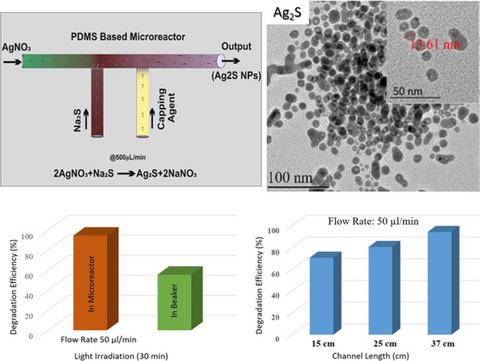当前位置:
X-MOL 学术
›
Photochem. Photobiol.
›
论文详情
Our official English website, www.x-mol.net, welcomes your feedback! (Note: you will need to create a separate account there.)
Continuous Flow Reactor for The Controlled Synthesis and Inline Photocatalysis of Antibacterial Ag 2 S Nanoparticles
Photochemistry and Photobiology ( IF 3.3 ) Pub Date : 2020-07-28 , DOI: 10.1111/php.13297 Bhanu Prakash 1 , Vibhav Katoch 1 , Asmita Shah 1 , Manju Sharma 1 , M Manolata Devi 1 , Jiban J Panda 1 , Jadab Sharma 2 , Ashok Kumar Ganguli 1, 3
Photochemistry and Photobiology ( IF 3.3 ) Pub Date : 2020-07-28 , DOI: 10.1111/php.13297 Bhanu Prakash 1 , Vibhav Katoch 1 , Asmita Shah 1 , Manju Sharma 1 , M Manolata Devi 1 , Jiban J Panda 1 , Jadab Sharma 2 , Ashok Kumar Ganguli 1, 3
Affiliation

|
The present study is focused on the integration of microreactors to synthesize visible light active nanophotocatalysts for inline photocatalytic degradation of organic dye and antibacterial activity. A wire‐assisted and a rapid laser micromachining technique has been employed for the fabrication of polydimethylsiloxane (PDMS) and poly(methyl methacrylate) (PMMA)‐based microreactors, respectively. By varying the design and chemical reagents involved, different sizes of visible light active Ag2S nanoparticles were prepared via a continuous microfluidics approach using fabricated microreactors. When polyvinylpyrrolidone (PVP) was utilized as the capping agent during the reaction, smaller particles of the size of ~ 15 nm were observed. The photocatalytic performance of these nanoparticles has been evaluated inline by employing the single‐inlet planar microreactor as a function of flow rate and channel length. The photocatalyst durability test and a comparative photocatalytic efficiency study between the microreactor and the conventional beaker reactor have also been carried out. Under visible light, these nanoparticles exhibit a remarkable enhancement of ~ 94.5% in the inline microreactor‐based photocatalytic degradation of methylene blue dye. The slower the flow rate and longer the channel length, gradual enhancement in the performance has been observed. Also, these nanoparticles express an antibacterial effect with very high efficacy even at very low (2 mg mL−1) concentration toward the inhibition of Escherichia Coli.
中文翻译:

用于抗菌 Ag 2 S 纳米颗粒可控合成和在线光催化的连续流动反应器
本研究的重点是集成微反应器以合成可见光活性纳米光催化剂,用于有机染料的在线光催化降解和抗菌活性。线辅助和快速激光微加工技术分别用于制造聚二甲基硅氧烷(PDMS)和聚(甲基丙烯酸甲酯)(PMMA)基微反应器。通过改变所涉及的设计和化学试剂,使用制造的微反应器通过连续微流体方法制备了不同尺寸的可见光活性 Ag2S 纳米粒子。当聚乙烯吡咯烷酮 (PVP) 在反应过程中用作封端剂时,观察到约 15 nm 的较小颗粒。通过采用单入口平面微反应器作为流速和通道长度的函数,在线评估了这些纳米颗粒的光催化性能。还进行了微反应器和传统烧杯反应器之间的光催化剂耐久性测试和比较光催化效率研究。在可见光下,这些纳米粒子在基于在线微反应器的亚甲基蓝染料光催化降解中表现出约 94.5% 的显着增强。流速越慢且通道长度越长,已经观察到性能的逐渐增强。此外,即使在非常低(2 mg mL-1)的浓度下,这些纳米颗粒也表现出非常高效的抗菌作用,以抑制大肠杆菌。还进行了微反应器和传统烧杯反应器之间的光催化剂耐久性测试和比较光催化效率研究。在可见光下,这些纳米粒子在基于在线微反应器的亚甲基蓝染料光催化降解中表现出约 94.5% 的显着增强。流速越慢且通道长度越长,已经观察到性能的逐渐增强。此外,即使在非常低(2 mg mL-1)的浓度下,这些纳米颗粒也表现出非常高效的抗菌作用,以抑制大肠杆菌。还进行了微反应器和传统烧杯反应器之间的光催化剂耐久性测试和比较光催化效率研究。在可见光下,这些纳米粒子在基于在线微反应器的亚甲基蓝染料光催化降解中表现出约 94.5% 的显着增强。流速越慢且通道长度越长,已经观察到性能的逐渐增强。此外,即使在非常低(2 mg mL-1)的浓度下,这些纳米颗粒也表现出非常高效的抗菌作用,以抑制大肠杆菌。这些纳米粒子在基于在线微反应器的亚甲基蓝染料光催化降解中表现出约 94.5% 的显着增强。流速越慢且通道长度越长,已经观察到性能的逐渐增强。此外,即使在非常低(2 mg mL-1)的浓度下,这些纳米颗粒也表现出非常高效的抗菌作用,以抑制大肠杆菌。这些纳米粒子在基于在线微反应器的亚甲基蓝染料光催化降解中表现出约 94.5% 的显着增强。流速越慢且通道长度越长,已经观察到性能的逐渐增强。此外,即使在非常低(2 mg mL-1)的浓度下,这些纳米颗粒也表现出非常高效的抗菌作用,以抑制大肠杆菌。
更新日期:2020-07-28
中文翻译:

用于抗菌 Ag 2 S 纳米颗粒可控合成和在线光催化的连续流动反应器
本研究的重点是集成微反应器以合成可见光活性纳米光催化剂,用于有机染料的在线光催化降解和抗菌活性。线辅助和快速激光微加工技术分别用于制造聚二甲基硅氧烷(PDMS)和聚(甲基丙烯酸甲酯)(PMMA)基微反应器。通过改变所涉及的设计和化学试剂,使用制造的微反应器通过连续微流体方法制备了不同尺寸的可见光活性 Ag2S 纳米粒子。当聚乙烯吡咯烷酮 (PVP) 在反应过程中用作封端剂时,观察到约 15 nm 的较小颗粒。通过采用单入口平面微反应器作为流速和通道长度的函数,在线评估了这些纳米颗粒的光催化性能。还进行了微反应器和传统烧杯反应器之间的光催化剂耐久性测试和比较光催化效率研究。在可见光下,这些纳米粒子在基于在线微反应器的亚甲基蓝染料光催化降解中表现出约 94.5% 的显着增强。流速越慢且通道长度越长,已经观察到性能的逐渐增强。此外,即使在非常低(2 mg mL-1)的浓度下,这些纳米颗粒也表现出非常高效的抗菌作用,以抑制大肠杆菌。还进行了微反应器和传统烧杯反应器之间的光催化剂耐久性测试和比较光催化效率研究。在可见光下,这些纳米粒子在基于在线微反应器的亚甲基蓝染料光催化降解中表现出约 94.5% 的显着增强。流速越慢且通道长度越长,已经观察到性能的逐渐增强。此外,即使在非常低(2 mg mL-1)的浓度下,这些纳米颗粒也表现出非常高效的抗菌作用,以抑制大肠杆菌。还进行了微反应器和传统烧杯反应器之间的光催化剂耐久性测试和比较光催化效率研究。在可见光下,这些纳米粒子在基于在线微反应器的亚甲基蓝染料光催化降解中表现出约 94.5% 的显着增强。流速越慢且通道长度越长,已经观察到性能的逐渐增强。此外,即使在非常低(2 mg mL-1)的浓度下,这些纳米颗粒也表现出非常高效的抗菌作用,以抑制大肠杆菌。这些纳米粒子在基于在线微反应器的亚甲基蓝染料光催化降解中表现出约 94.5% 的显着增强。流速越慢且通道长度越长,已经观察到性能的逐渐增强。此外,即使在非常低(2 mg mL-1)的浓度下,这些纳米颗粒也表现出非常高效的抗菌作用,以抑制大肠杆菌。这些纳米粒子在基于在线微反应器的亚甲基蓝染料光催化降解中表现出约 94.5% 的显着增强。流速越慢且通道长度越长,已经观察到性能的逐渐增强。此外,即使在非常低(2 mg mL-1)的浓度下,这些纳米颗粒也表现出非常高效的抗菌作用,以抑制大肠杆菌。


























 京公网安备 11010802027423号
京公网安备 11010802027423号